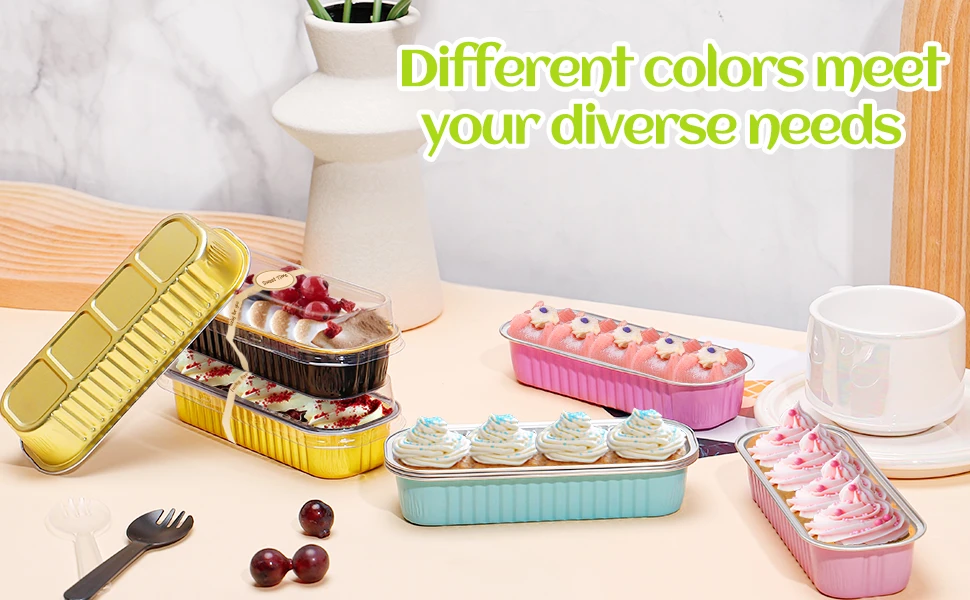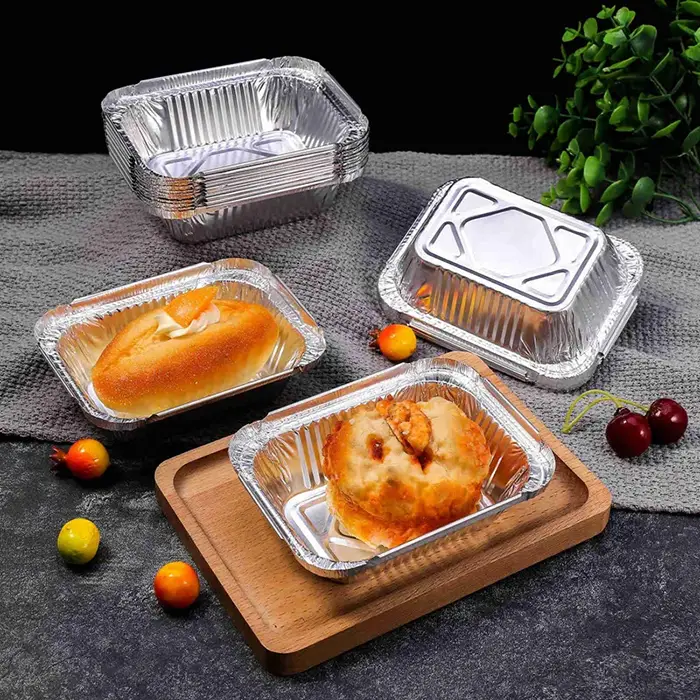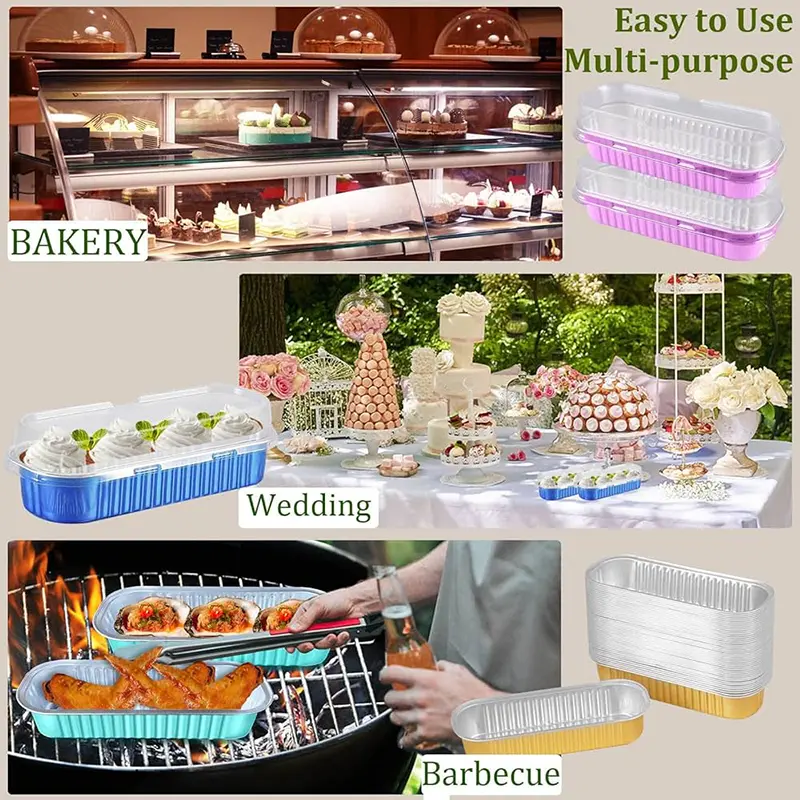Foil cake pans are the most commonly used baking utensils, they are lightweight, high temperature resistant, and can be used directly in the oven. It is usually round in shape, with a flat bottom and high edge pleats all around to ensure that the cake is evenly heated and is easy to remove from the mold. Aluminum foil cake pan is disposable and can be discarded directly after use. This aluminum product is recyclable, so you don’t have to worry about environmental pollution.

This article will focus on baking tips for aluminum cake pans to help you enjoy your baking time!
Choose Right Aluminum Foil Cake Pan
Learn About Size and Shape
- Foil cake pans come in round, rectangular, square, and even foil heart shaped cake pans. It depends on what type of cake you want to make. Common cake foil pan sizes are: 1 2 sheet foil cake pan, 1/4 sheet foil cake pan, 8 inch foil cake pans, 9 inch foil cake pans, 9 x 13 aluminum foil pan with lid.
Disposable vs Reusable Pans
- Foil cake pans are available in both disposable and reusable options. Disposable foil pans are convenient and easy to clean, making them ideal for bakers. Reusable foil cake pans are more environmentally friendly and have better quality and durability.
Nonstick vs Regular Cake Foil Pan
- Some cake foil pans come with non-stick coatings that prevent sticking and allow the cake to be released easily. You can also oil a regular aluminum foil pan to prevent it from sticking.
Preparing for Baking
Oil The Pan
- The oil creates a barrier between the batter and the surface of the pan, which effectively prevents the cake from sticking. Use baking spray or brush the pan with butter or oil, coating every nook and cranny evenly.

Spread Parchment Paper
- To prevent sticking, consider lining a foil cake pan with parchment paper. Cut a piece of parchment paper to cover the bottom of the pan, extending it slightly up the sides. The parchment paper not only helps to remove the cake easily, but also helps keep the pan clean.
Add Flour or Cocoa Powder
- After you grease the pan, sprinkle a small amount of flour or cocoa powder and tap the sides of the pan to evenly distribute it. This layer of flour or cocoa powder creates a barrier between the batter and the pan, further preventing sticking.
Ensure Even Baking
Ensure Heat Distribution
- Baking pans conduct heat differently than traditional cake pans, so place the filled foil cake pan in the center of the oven and avoid placing it too close to the oven walls or heating elements.
Use Insulated Foil Cake Pan
- Insulated foil cake pans have an extra layer of insulation. The insulation helps prevent hot spots and ensures the cake bakes evenly from edges to center, avoiding scorching.
Use Heating Core or Flower Nails
- When baking larger or denser cakes in a foil pan, using a heating core or flower pin can help you bake evenly. A heating core is a metal spike placed in the center of a pan filled with batter, allowing heat to penetrate the core of the cake more efficiently. Likewise, a flower pin (a metal nail with a flat head) can be placed upside down in the batter to help distribute heat. These tools help prevent the center of the cake from being underbaked and the edges cooked.
Prevent Scorching

Adjust Oven Temperature
- To prevent the top of the cake from getting too brown, lowering the temperature slightly can help slow down the browning process. You can reduce the risk of scorching by paying close attention to the baking time and adjusting the temperature as needed.
Making an Aluminum Foil Tent
- If you find that your cake is browning too quickly but still needs more time to bake, tear off a piece of aluminum foil large enough to create a foil tent and lightly cover the cake with the foil, leaving some room for air to circulate. The foil tent acts as a shield, preventing over-browning while allowing the cake to continue baking to perfection.
Monitor Baking Time Closely
- Foil cake pans may bake faster than traditional pans due to the heat-conducting properties of foil. Set a baking timer and check the cake baking progress a few minutes before the end. Insert a toothpick or cake tester into the center of the cake to check for doneness. If it comes out clean or with some moist crumbs, the cake is ready to be removed from the oven.
Keep Cake Moist
Add Water Bath
- Water bath is where a foil cake pan is placed in a larger pan of hot water. The water acts as a buffer, providing heat to the cake while also adding moisture to the oven environment. This method is particularly suitable for baking delicate cakes such as cheesecakes and custard cakes.
Use Parchment Circles
- Cut a strip of parchment paper long enough to wrap around the sides of the foil cake pan, extending a few inches above the edge. Secure the parchment paper strips around the pan with paper clips or kitchen twine. The parchment paper circle helps insulate the cake and prevent it from drying out during baking.
Brush Syrup
- Once the cake has cooled slightly, use a pastry brush to spread the syrup over the top and sides of the cake. Syrup not only adds moisture but also enhances the flavor and texture of the cake.
Take Out Cake
- After removing the cake from the oven, allow it to cool in the foil pan for a few minutes. Transfer the foil cake pan to a cooling rack and let the cake cool completely.
- Once the cake has cooled, place a plate or cake board on top of the pan, making sure it covers the entire opening. Gently tap the bottom of the pan to remove completely. Once the cake is out of the pan, it’s time to remove the foil. Start by finding the edge of the foil and carefully pulling it away from the cake. If the cakes are sticking to the foil, you can use a butter knife or spatula to gently separate them.
Decorate Cake
Transfer Cake to Plate
- Transfer cake to a plate or cake stand. You can use a cake lift or slide a few wide spatulas under the cake to lift and move it.
Decorating Tips
- Once the cake is on a plate, you can use your creativity and taste to decorate it. Spread buttercream, whipped cream or ganache on cake, or use an offset spatula or piping bag to create decorative patterns, swirls or rosettes. Add edible garnishes such as fresh fruit, chocolate chips or sprinkles.

Cleaning and Storage
Cleaning
- Cleaning foil cake pans is best done by hand, fill a sink or basin with warm soapy water, and gently clean the pan with a soft sponge or cloth. Rinse the pan thoroughly to remove any soap residue, then pat dry with a clean towel.
Storage
- Allow the pan to air dry completely or dry it by hand using a clean towel. Once dry, store the foil cake pan in a dry, cool place away from direct sunlight and moisture. The best way is to place a layer of parchment paper or a clean cloth between the pans to prevent scratches.
Replace in Time
- Foil cake pans are usually durable and can be reused many times. However, over time, they may become less sturdy or show signs of wear. It’s a good idea to check your foil pan regularly and replace it immediately if you notice any obvious damage, such as bent edges, holes, or peeling coating.
